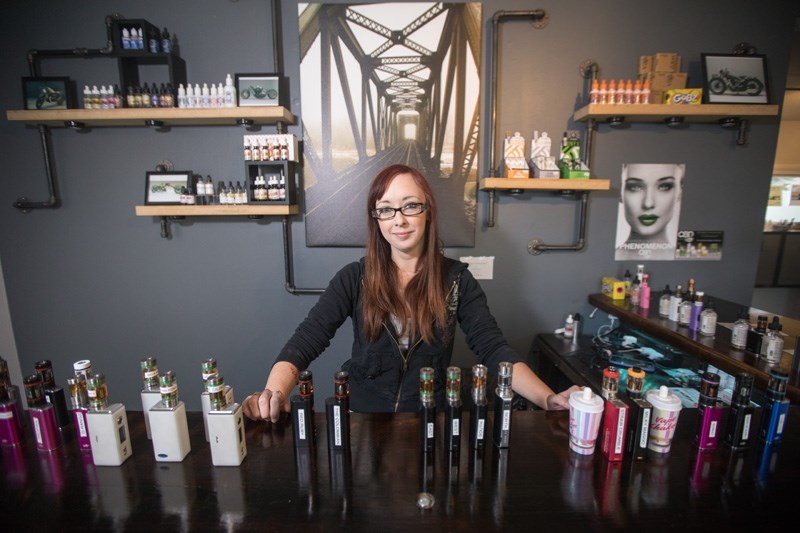Proposed regulations on vaping are welcomed by many in the business, as long as they don’t go too far.
Kathleen Hurtak, manager of Dieslpunk Vape Co. in Okotoks, said their store is pleased to see age restrictions as well as cleanliness and health standards come into play in the industry.
“I think it’s great for regulations to come in, especially enforcing not selling to minors and that sort of thing,” said Hurtak.
Health Canada announced Sept. 27 it would bring forward legislation this fall that would balance the need to protect young people from nicotine addictions but still allow adults smokers to use vaping products as an alternative to smoking.
Since Dieselpunk opened just over a year ago they’ve never allowed minors in their store – a condition of their development permit approval with the Town of Okotoks, she said.
She said there aren’t formal federal regulations on selling to minors, but the province can issue fines and the Town could revoke their business license.
For the most part, she said vape shops self-regulate and some suppliers have a “no-sell” list and refuse to sell to stores catering to minors or guilty of other ethics violations, she said.
Manufacturing standards are welcome to make sure there are quality products out there, Hurtak said.
“When it comes to the juice, it should be insisted that it’s made in a sterilized lab with full food safety standards,” said Hurtak. “If we’re inhaling it, it should be clean and safe.”
She said Dieslpunk does its due diligence with juice manufacturers, testing new products before ordering and requesting lab reports and certification before stocking juice in their store. Unfortunately, she said not all purveyors are as thorough.
“A lot of stores will buy what’s cheap and sometimes they’re not using quality products and they’re made in someone’s bathtub,” said Hurtak. “So in terms of regulations that way I think it’s going to be a great thing.”
There are some concerns, she said. She hopes the vaping industry won’t be lumped into the general tobacco industry that would see taxes come into place.
The biggest fear is that the Canadian government takes a heavy-handed approach similar to the FDA decision in the US, which saw vape products heavily taxes and classified items like replacement batteries as tobacco products. It also implemented a mandatory fee for people testing vapes prior to purchase.
“The States is going to crush a lot of small businesses and I don’t think that’s a great approach to take,” said Hurtak. “If the same regulations came here our store probably would be out of business too.”
Beju Lakhani, former president of the Canadian Vaping Association, said government regulations are long overdue and so far it looks as though the Canadian government is going a different direction than the US.
“I’m really happy with the direction they appear to be going in,” said Lakhani.
He said the government’s statement seemed to acknowledge the potential benefits of vaping technology, which he was pleased to see.
“I think in the last couple of years you’ve seen more and more science coming out to support the idea that e-cigarettes do present a net public health benefit and the federal government seems to be acknowledging that,” said Lakhani.
Without regulations, provinces have been trying to find their own way and it’s posed a challenge across the country, he said. In Quebec, he said regulations put in place in 2015 completely missed the mark and he hopes the federal rules will help bring it in check.
Vaping products were all brought under the same regulations as tobacco in Quebec in the fall of 2015. This included removing all advertising, covering up shop windows, not allowing people to test products in the store, and banning e-cigarettes from open terraces, patios, and sports fields used by children. Flavourants were also banned, along with all flavoured tobacco products.
“I think Quebec totally missed the point of what the average consumer of an e-cigarette is trying to do – quit smoking,” said Lakhani. “By lumping it in with tobacco they’ve, whether they like this or not, hurt the ability of someone who’s actually trying to quit.”
He said while he agrees with any product safety standards and restricting access to minors, limiting access to adults looking to switch from traditional to electronic cigarettes would be concerning.
“I do believe that’s not the direction the federal government is going,” said Lakhani. “Their statement seems to reaffirm that, and I think we will see regulations that do acknowledge the public health benefit here.”
Foothills MP John Barlow said he’s happy to see any regulation that will keep tobacco out of the hands of minors and discourage smoking, but he said making vaping a priority right now sends a mixed message.
“This is a mixed message from the government,” said Barlow. “You want to make it more difficult to do vaping and those kinds of things, but make access to marijuana easier, that’s an interesting conundrum on that message.”


.png;w=120;h=80;mode=crop)

